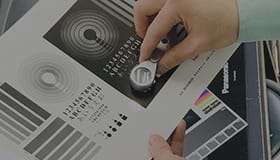Product overview
XG VARNISH 3/1000 is an Acrylic based evaporation dry type, one pack curing clear. It was developed as an easy-to-use overcoat clear for PVC stickers.
- Functional ink

Application
- Overcoat clear for PVC stickers
- Overcoat clear for VK, and VG inks.
-
Automobile, Motorcycle
-
Home Appliance (IoT)
-
Smartphone, Tablet, Smart watch
-
Sensor
-
Game
-
Others
Features, Function
- Excellent adhesion to PVC stickers
- Good balance of hardness and softness, excellent in various resistances
- Glossy and excellent in gasoline resistance
Substrate
- PVC sheet
- PVC
Dilution
- M-002 SOLVENT(standard) Dilution: 15 to 30%
Recommended cleaner
- Screen Cleaner L2
Mesh
- T 180 to 225 mesh(Coverage is 35 to 45m2/kg at 200 mesh)
Drying
- 60℃ 30 to 60 min
- *Ensure sufficient drying After drying for 1 hr. at 60℃, leave on rack for 1 hr. then pile up. Application tape can also be applied immediately after drying for 1 hr. at 60℃.
Caution
- Checking before production: Adhesion and resistance properties may change due to differences in substrates, processes, printing and drying conditions. Be sure to check the adhesiveness and resistance properties before mass production printing.
- Ink shelf life: 24 months from production date, unopened.
Safety
- UN No.: 1210
- UN Classification: Class 3 Flammable Liquids(Flash point is over 23 Degree C)
Handling
- Use safety gloves and eyeglasses to protect skin and eyes. If the ink comes in contact with skin, wash with soap and plenty of water (or lukewarm water) and consult with a doctor.
- Containers should be closed tightly after use and stored in a cool and dark place.
- SDS is available upon request. Please request a copy and read it carefully before handling the products.
Resistance
| Test item | Test Conditions | Test results |
|---|---|---|
| Heat | JISK5600-6-3:ISO 3248: 80℃, 168 hrs. check appearance and peel off | No defect |
| Hot Water | JIS K5600-6-2, Soak 168 hrs. in 40℃ hot water, check appearance and peel off | No defect |
| Humidity and cool-heat cycling test | JIS K5600-7-4 3 cycles:80℃(4.5 hrs.)~20℃(0.5 hrs.)~-30℃(4 hrs.)~20℃(0.5 hrs.)~50℃ 95%RH(14 hrs.)~20℃(0.5 hrs.) check appearance and peel off | No defect |
| Boiling | Soak 5 min in boiling water, check appearance and peel off from the substrate | No defect |
| Oil | Soak 1 hr. in kerosene, check appearance | No defect |
| Window washer | Soak 1 hr. in window-washer, check appearance and peel off from the substrate | No defect |
| Wax remover | Soak 1 hr. in wax-remover, check appearance and peel off from the substrate | No defect |
| Gasoline | Soak 1 hr. in gasoline, check appearance and peel off from the substrate | No defect |
| Scrub | Gakushin scrub tester, cotton, 1kg weight, 50 back and forth, check colorfade | No defect |
| Abrasion | JIS K5600-5-9:ISO7784-2(Abrasion ring method),1kg weight, CS17 abrasion ring, 100 times, check exposure of substrate | No defect |
| Shrink by heat | 100mm×100mm prints, after 48 hrs. at 70℃, check dimension change: ≦0.1% | No defect |
| Accelerated weathering (Carbon-arc) | JIS K5400 9.8.1 Weather meter with carbon arc,:BP Temp.63+/-3℃:Raining rate 18 min/120 min, check color fade and peel off | (800-1000 hrs.) No defect |
| Natural weathering | JISK5600-7-6、Exposure in Tokyo, check color fade and peel off | (1 year) No defect |
Test Condition
- Test conditions 【XG VANISH 3/1000】【M-002 SOLVENT 15%】【T 180】 【60℃ 60 min】 【Substrate: PVC sticker: Hi-S Cal 5010 White】 【Tested by overcoating on VK-911 BLACK, 391 BLUE, and Silver printed materials】
- Above resistance test results are measured results in our laboratory and they are not guaranteed values.
- Information contained in this catalog may change without prior notice.
FAQ
-
What is screen printing?
-
Screen printing is a type of stencil printing which uses a technique of duplicating the image from a design made on mesh stencils.
When printing ink goes through the mesh, it transfers the image onto the substrate material. Other than air and water, any substrate materials are printable. Not only flat surfaces, but also curved, specially shaped, and molded products are suitable for screen printing.
- Related inks

